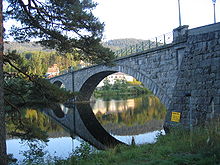Treungenbanen
| Treungen – Arendal | |||||||||||||||||||||||||||||||||||||||||||||||||||||||||||||||||||||||||||||||||
|---|---|---|---|---|---|---|---|---|---|---|---|---|---|---|---|---|---|---|---|---|---|---|---|---|---|---|---|---|---|---|---|---|---|---|---|---|---|---|---|---|---|---|---|---|---|---|---|---|---|---|---|---|---|---|---|---|---|---|---|---|---|---|---|---|---|---|---|---|---|---|---|---|---|---|---|---|---|---|---|---|---|
|
Arendal train station
| |||||||||||||||||||||||||||||||||||||||||||||||||||||||||||||||||||||||||||||||||
| Route length: | 91 km | ||||||||||||||||||||||||||||||||||||||||||||||||||||||||||||||||||||||||||||||||
| Gauge : | 1435 mm ( standard gauge ) until 1946: 1067 mm |
||||||||||||||||||||||||||||||||||||||||||||||||||||||||||||||||||||||||||||||||
| Power system : | (Nelaug – Arendal) 15 kV 16⅔ Hz ~ | ||||||||||||||||||||||||||||||||||||||||||||||||||||||||||||||||||||||||||||||||
|
|||||||||||||||||||||||||||||||||||||||||||||||||||||||||||||||||||||||||||||||||
Treungenbanen was a single-track, narrow-gauge local railway in the southern Norwegian province of Agder when it opened . It ran between Treungen and the city of Arendal .
history
The route was planned by the Norges Statsbaner as a local railway and built in Cape Gauge to connect Arendal with the most important places on the Nidelva . In 1908 the first section to Froland was opened, in 1910 it was extended to Åmli and in 1913 the line reached Treungen .
The branch line from Rise station to Grimstad was built as a private railway, but was taken over by NSB on January 24, 1912 and operated as Grimstadbanen . Alongside passenger traffic, timber and ore were the main goods on this route.
In 1935 the Sørlandsbane reached Nelaug, the Treungenbane became its branch line. In order to be able to end the Sørlandsbane as an interim solution in Arendal, the Arendal – Nelaug section was converted to standard gauge . This section of the route is part of the Norwegian rail network under the name Arendalsbanen .
On November 9, 1935, the first train drove from Oslo Westbahnhof to Arendal. King Håkon VII , Crown Prince Olav and Prime Minister Johan Nygaardsvold were among the guests .
During the next three years, Arendal was the largest transfer point in southern Norway: travelers from western Norway had to change from steamboat to train here on their way to the capital.
As long as the northern section was still narrow gauge, all goods had to be reloaded in Nelaug. Therefore, the northern section was also converted to standard gauge in 1946. The Søftestad ore mine was the route's largest customer, with several trains per week running from the mine to Arendal. The ores were exported to Central Europe, especially to Germany. For a number of years the annual transport capacity was around 30–40,000 tons of ore.
In 1965 the mine was closed. In 1967 the Storting decided to cease operations on the route between Nelaug and Treungen. The road connection between Åmli and Nissedal was expanded and the railway was replaced by a bus line from Arendal to western Telemark . In 1969 the dismantling of the northern section began, on which a cycle path was laid for the most part.
Today, timber is transported on the remaining stretch between Nelaug and Simonstad. The southern section to Arendal, today's Arendalsbane, was electrified in 1995.
literature
- Roy Owen: Norwegian Railways - from Stephenson to high-speed . Balholm Press, Hitchin 1996, ISBN 0-9528069-0-8 (English).

